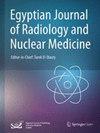Role of diffusion weighted imaging with background body signal suppression (DWIBS) in diagnosis of breast masses and correlation with histopathological findings
IF 0.5
Q4 RADIOLOGY, NUCLEAR MEDICINE & MEDICAL IMAGING
Egyptian Journal of Radiology and Nuclear Medicine
Pub Date : 2024-05-13
DOI:10.1186/s43055-024-01260-9
引用次数: 0
Abstract
Dynamic contrast-enhanced magnetic resonance imaging (DCE-MRI) is the important tool in breast imaging. However, two major limitations are represented by its specificity and by the injection of contrast material. Diffusion weighted imaging (DWI) provides important functional information without the need for contrast material. A newly introduced diffusion weighted imaging with background suppression (DWIBS) sequence is an accurate and rapid tool for the identification and characterization of breast lesions, with its short examination time, high lesion-to-background contrast and lack of need for intravenous contrast agents. To assess the role of DWIBS sequence in the evaluation of indeterminate and suspicious breast masses and to compare its accuracy with DCE-MRI in correlation with histopathological findings. Thirty-five patients were included in the study, referred from sono-mammography clinic to MRI unit for further MRI assessment of probably benign, suspicious and malignant looking breast masses (BIRADS 3, BIRADS 4 & BIRADS 5) on sono-mammography imaging results. MRI breast protocol which included DCE-MRI and DWIBS sequences were obtained for characterization and were verified by core needle biopsy or excisional biopsy. The results were statistically analyzed. Sensitivity, specificity, diagnostic accuracy (DA), positive predictive value (PPV) and negative predictive value (NPV) were calculated for DCE-MRI and DWIBS. Apparent diffusion co-efficient (ADC) values were calculated with ADC ≤ 1.2 × 10−3 mm2/s was considered suspicious for malignancy. The results were then compared with the histological findings. Thirty-five female patients had 39 breast masses included in our study. By DCE-MRI, 8 (20.5%) masses were categorized as benign and 31(79.5%) masses were categorized as malignant. By DWIBS sequence, 7 (17.9%) masses were categorized as benign and 32 (82.1%) masses were categorized as malignant. By histopathology, 14 (35.9%) masses were benign and 25 (64.1%) masses were malignant. DCE-MRI obtained accuracy, sensitivity, specificity, PPV and NPV values of 84.6, 100, 57.1, 80.6 and 100%, respectively. DWIBS sequences obtained accuracy, sensitivity, specificity, PPV and NPV values of 82.1, 100, 50, 78.1and 100%, respectively. DWIBS can be added to DCE-MRI, as complementary tool to make radiologist more confident about the diagnosis. It can also be used instead of DCE-MRI sequences in certain circumstances such as in cases of renal impairment.带背景体信号抑制的弥散加权成像(DWIBS)在诊断乳腺肿块中的作用以及与组织病理学结果的相关性
动态对比增强磁共振成像(DCE-MRI)是乳腺成像的重要工具。然而,它的特异性和注射造影剂是其两大局限。弥散加权成像(DWI)无需使用造影剂即可提供重要的功能信息。新推出的背景抑制弥散加权成像(DWIBS)序列检查时间短,病变与背景对比度高,无需静脉注射造影剂,是准确、快速识别和描述乳腺病变的工具。目的:评估 DWIBS 序列在评估不确定和可疑乳腺肿块中的作用,并比较其与 DCE-MRI 在与组织病理学结果相关性方面的准确性。研究共纳入 35 名患者,他们都是从声波乳腺造影诊所转诊到磁共振成像室,根据声波乳腺造影成像结果对可能是良性、可疑和恶性的乳腺肿块(BIRADS 3、BIRADS 4 和 BIRADS 5)进行进一步的磁共振成像评估。核磁共振乳腺成像方案包括 DCE-MRI 和 DWIBS 序列,用于确定特征,并通过核心针刺活检或切除活检进行验证。对结果进行了统计分析。计算了 DCE-MRI 和 DWIBS 的敏感性、特异性、诊断准确性(DA)、阳性预测值(PPV)和阴性预测值(NPV)。计算表观弥散系数(ADC)值,ADC≤1.2×10-3 mm2/s为可疑恶性肿瘤。然后将结果与组织学结果进行比较。35名女性患者共有39个乳腺肿块。通过 DCE-MRI,8 个(20.5%)肿块被归类为良性,31 个(79.5%)肿块被归类为恶性。通过 DWIBS 序列,7 个(17.9%)肿块被归类为良性,32 个(82.1%)肿块被归类为恶性。通过组织病理学检查,14 个肿块(35.9%)为良性,25 个肿块(64.1%)为恶性。DCE-MRI 的准确性、敏感性、特异性、PPV 和 NPV 值分别为 84.6、100、57.1、80.6 和 100%。DWIBS序列的准确性、敏感性、特异性、PPV和NPV值分别为82.1、100、50、78.1和100%。DWIBS 可作为 DCE-MRI 的补充工具,使放射科医生对诊断更有信心。在某些情况下,例如肾功能受损的病例,也可以用 DWIBS 代替 DCE-MRI 序列。
本文章由计算机程序翻译,如有差异,请以英文原文为准。
求助全文
约1分钟内获得全文
求助全文
来源期刊

Egyptian Journal of Radiology and Nuclear Medicine
Medicine-Radiology, Nuclear Medicine and Imaging
CiteScore
1.70
自引率
10.00%
发文量
233
审稿时长
27 weeks
 求助内容:
求助内容: 应助结果提醒方式:
应助结果提醒方式:


